Report on the Reference Collection of the Textile Conservation Centre
- Nov 20, 2018
- By Stephen Cole
- In Articles + Papers
The work on cataloguing the Collection began in 1975 when it was moved from 7 Western Gardens, Ealing to Hampton Court Palace.
There were many difficulties to overcome because of the lack of space and inadequate facilities and progress was slow until 1985 when the Warrant of the third apartment for the Centre was given and the generosity of the Clothworkers’ Foundation enabled the installation of bookcases for the library and fitted cupboards arranged in sections for the Collection.
Eight sections on two walls are fitted with twelve trays each. The first two sections provide examples of techniques, the next six sections are intended to give a chronological overview of how the techniques were used and developed in accord with the influence of fashion and technological progress.
Each section is arranged for the purpose of showing textiles made at the same time in various cultures.
The final row of cupboards makes provision for hanging space to show a few pieces of dress illustrating dressmaking techniques and their development before and after the advent of the sewing machine. There is also space for a few rollers for large pieces that cannot go into the trays.
Upper cupboards contain uncatalogued material for use in conservation and to illustrate the damage caused by wear and tear, incompatibility and environmental problems. There are special collections of tapestry and upholstery materials and techniques for demonstration and a section with objects conserved by the students as coursework.
The grant of £7,000 from the Radcliffe Trust for covering the expenses for one year of cataloguing the collection, has enabled me to sort the material into groups outlined in the key to the Collection – Appendix A – and to discover that there are some areas in the chronological section that are not represented and a considerable surplus in others.
The Collection began as an extension to my specialised library of books, postcards with textile subjects, magazines and journals, that now forms the nucleus of the Textile Conservation Centre’s library, and is intended as a vehicle for increasing the textile knowledge of the users in the swiftest possible time.
The Collection was first used as a teaching aid in 1969 when I was asked to provide an overview of textiles and their making to the History of Dress students at the Courtauld Institute of Art.
From 1975 when the Textile Conservation Course with the Institute began it became an adjunct to my lectures on the history of textile techniques. The collection helped me to put across the philosophy on which the course was founded, namely the treatment of artistically or culturally important textiles as documents of history. Equipment used for the teaching included the small Olympus microscope, the LERVAD loom and various types of narrow weave equipment from Denmark.
For the purpose of cross-referencing with the library, the conservation records and the photographic material two sets of two filing cabinets were purchased and installed in the library. The corresponding drawers in each set were for the files of completed commissions with before and after reports giving Textile Conservation Centre numbers only (clients names should be removed for security reasons).
The slides for every object should be in the cabinet on the left and the reports and black and white photographs in the corresponding drawer in the cabinet on the right so that the students may have easy access to learn from the case histories concerning commissions undertaken at the Centre by individual study which, since the subject is intensely visual, may be aided by viewing slides while comparing the techniques by which the objects were made, with the samples of similar techniques available in the collection. I suggest that my microscope is kept in the collection to provide the students with the means for close study in accord with the purpose for which it was originally bought.
The reports concerning students work on the Collection are separate to the reports on commissions and the objects conserved by the students are available for further study including of the long term effects of conservation.
When fully integrated with the library and conservation records the collection should form a unique teaching aid of benefit on several levels by:
- giving opportunities for close study of textiles in as many techniques as may be fitted into the space available.
- giving opportunities to study changes wrought by time and how these may manifest themselves.
- providing material for first conservation projects and methods of conservation.
- providing material for special research projects involving techniques, colour, finishing treatments and their reactions to display in different environments.
- providing teaching aids for short courses during vacations of full time students.
- providing material for study by interns and observers to make their stay at the Textile Conservation Centre less dependent on the space and time available for them in the workrooms.
The Collection includes pieces given by my family and friends or made by me at home and at Kunsthåndværkerskolen in Copenhagen. It grew from finds in junk shops, and jumble sales and was added to by those who became interested in my teaching and wished to find a home for pieces of no monetary value, but of interest for the purpose of providing samples of textile techniques. Chief among them were Ninna Rathje – late of the Historical Archaeological Research Centre at Lejre in Denmark, Jessie and Alice Jones, late of the Royal School of Needlework, Dorothea Spier, Doris Bradley, Nancy Sayer, Evelyn Birkill, late of the Victoria and Albert Museum, Genitha Halsey who was with me in Ealing, our neighbour Heather Campbell and Lady Faith Culme-Seymour. Since we came to Hampton Court Palace, major donors have included Everilda Gibbs, the Geffrye Museum, the Embroiderers’ Guild, Barbara Gardiner and Lady Gibson. Of Textile Conservation Centre members who have contributed special mention may be made of Kerstin Aronsson for a collection of wool samples.
From the beginning of the Collection in Ealing pieces of special interest because of their design or rarity were accepted on the proviso that if they were wanted for a museum collection, they would be given to that collection as from the original donor.
Besides the Victoria and Albert Museum recipients include the Costume Museum in Bath, the Court Dress Collection at Kensington Palace, the Geffrye Museum, Gunnersbury Museum, the Museum of London, the Royal Museums of Scotland, Temple Newsam House in Leeds, the Petrie Collection at University College, London, Ulster Museum and The Whitworth Gallery, Manchester.
The work for which the expenses have been covered by the Radcliffe Trust began in August 1986 by sorting the pieces into their appropriate trays. Because of the Reference Collection Room also being used for lectures it was essential that this work was done before October 1986 and the return of the students.
It was a colossal task reminiscent of playing with a Rubik’s Cube, but like this it got easier with time.
After the sorting of the collection the cataloguing began by identifying the pieces on a preliminary form – Appendix B – giving each piece a number and listing it in a ledger. Next the information from the preliminary sheet is listed on an index card that also makes provision for future cross-referencing with the library and conservation records and any further information concerning identification that may surface in the course of time.
Each piece is marked with a label or tag giving its number, section and tray location. The index cards should be available to the students, but the ledgers should be kept by the Teaching Department. Lists of the pieces kept in each tray have been made for the main trays of the techniques section.
The techniques and the major part of the chronological section have been identified. The surplus has been put into boxes and stored in the attic or on top of the cupboards; very few of the surplus pieces have been catalogued but all the boxes are being marked for content. Archival quality storage materials have been used together with acid free cardboard boxes.
From October 1986 the work was done in conjunction with my weekly lectures on the History of Textile Techniques. My teaching included setting two textile identification projects for the first year students – of which the project of Term II – Appendix C – on the narrow weaves in the Collection, proved particularly useful.
The major part of the cataloguing has been done in Ealing with help from a number of volunteers – first and foremost my husband Norman Finch, who has done all the fetching and carrying between Ealing and Hampton Court Palace and generally made this enormous task possible.
I am grateful to him and to Pamela Warner for her long involvement in the organisation of the Collection and her work on presenting the lace techniques, to Heather Campbell for secretarial assistance, to Judith Stoker for assistance with stitching on numbers and her help with practical organisation, to Anne Castelete and Audrey Aubrey-Fletcher of NADFAS for measuring the pieces and filling in Index Cards and to Anne Taylor for her work on the tabulation and presentation of the result of the students project on the identification of the narrow weaves and to all students past and present who have helped with the Collection.
I would also like to give special thanks to those involved earlier, to Stella Mary Newton whose interest and encouragement helped to turn the Collection into a teaching aid, to Greta Putnam for her practical help with the research, to Margaret Bartlett and Margaret Forbes who helped with identifying metal yarns in the Royal School of Needlework tradition, to Nancy Kimmins and her husband who helped to move the Collection to Hampton Court Palace, to Clara Lamb and to the group of volunteers from NADFAS who put labels on the pieces brought from Ealing. To Barbara Gardiner for facilitating the viewing of slides as part of the studies of case histories.
I thank them all and I thank all those who have given their time to help with the identification, especially our President and his wife – Donald and Monique King, who helped with the woven pieces and Santina Levey and Andrew Oddy who advised on general cataloguing.
I am grateful to members of staff at Kew Gardens and to many colleagues in Museums in Britain and abroad whose help and advice has been invaluable from the very beginning of the Collection and its use as a teaching aid, and to every member of the Centre, who have contributed their knowledge and made the Collection worthwhile – in particular Danielle Bosworth for her work with the silks and her teaching of weave analysis and the recognition of weaves. Her attendance over two years on the special CIETA Analysis Course in Lyon resulted in a very valuable report written especially for the students of the Textile Conservation Centre.
We are grateful to the Crafts Council for the grant that enabled Danielle to take part.
The imaginative use made by our Head of Studies and Research, Margaret Roberts of the Collection for teaching, has been made possible because of the work done by:
Danielle Bosworth
Caroline Clark
Stephen Cousens
Dinah Eastop
Jennifer Fitzgerald‐Bond
Elizabeth Flintoff
Maria Kralovansky
Marion Lamb
Frances Lennard
Sally Parks
Eileen Powell
Poppy Singer
Agnes Timar
Wendy Toulson
And on the initiative of Kathryn Gill who started the Upholstery Collection and Sherry Doyal who expanded it and who came to the Centre outside working hours to put this section in order. The Collection also owes much to the research on the recognition of fibres, chemical treatments and colour done by Nicholas Eastaugh and Anthony Smith.
I am grateful to the Clothworkers Company for enabling the Textile Conservation Centre to put up the beautiful purpose built housing of the library and the Collection, and to the Radcliffe Trust for granting funding for the expenses of the cataloguing. Between them they have made the Collection accessible and put the crowning glory on the work of all those who have helped to create this special teaching aid.
I have had to decide to complete only the work planned for the first three stages of turning the Collection into the unique study resource – Appendix D – for which it was intended when the Course with the Courtauld Institute of Art was set up in 1975.
The work on identification should not be considered complete until the verification provided for in paragraph eleven. The various stages need not be done in the order outlined.
About 1500 pieces have been described and catalogued.
Awaiting individual descriptions are the Collection of:
- Rug and Tapestry pieces
- Costumes in the hanging section
- Hats in the attic store
- Ladies Caps
- Handkerchiefs and Scarves
- Feathers and Flower decorations
- Fur garments and pieces
- Cane and Straw
- Yarns and Threads
- Equipment for weaving, printing and lacemaking
- Dressmaking Accessories
- Pieces conserved by the students
For the purpose of becoming familiar with the Reference Collection as a whole, these individual collections could form useful first year students projects of identification and grouping.
Students may also acquire familiarity with the Collection through projects concerning cross-reference indexes – Appendix E – and preparing lists of contents for each tray.
The Collection has been put together from the material available and reflects my own interest in techniques and conservation but is in no sense fully representative of all the aspects a conservator may encounter. The tray marked ‘Colour’ is a good example of this fact. The pieces include examples of dyed fabrics and yarns to illustrate built in damage caused by dyestuffs and changes caused by fading and decay but very few straight colour samples.
The identification of dyestuffs in the Collection might begin with this tray and serve several purposes including providing analytical identification experience for the students and increasing the usefulness of the Collection as a whole.
I hope the work will go on and the Collection grow in usefulness and continue to suit the needs of teaching but should the Collection no longer be used for the purpose of teaching on the Course with the Courtauld Institute of Art, I would wish to be given back my looms and microscope together with the pieces which were brought from Ealing when the Centre was set up in 1975 and to make the same proviso for the books marked with my name, which were retained by the Centre on my retirement in 1986.
Karen Finch OBE FRSA FIIC
Founder of the Textile Conservation Centre
at Hampton Court Palace


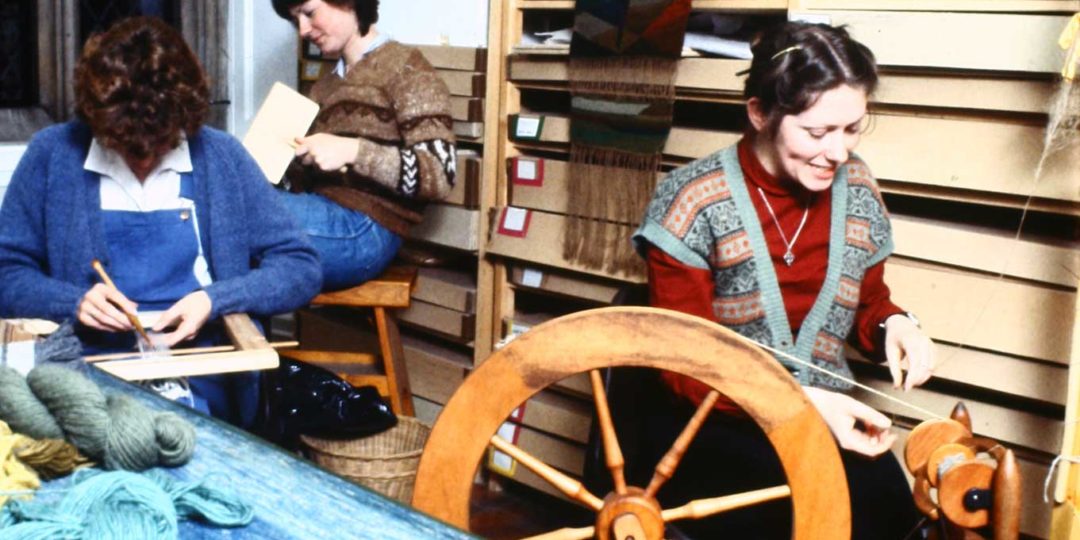
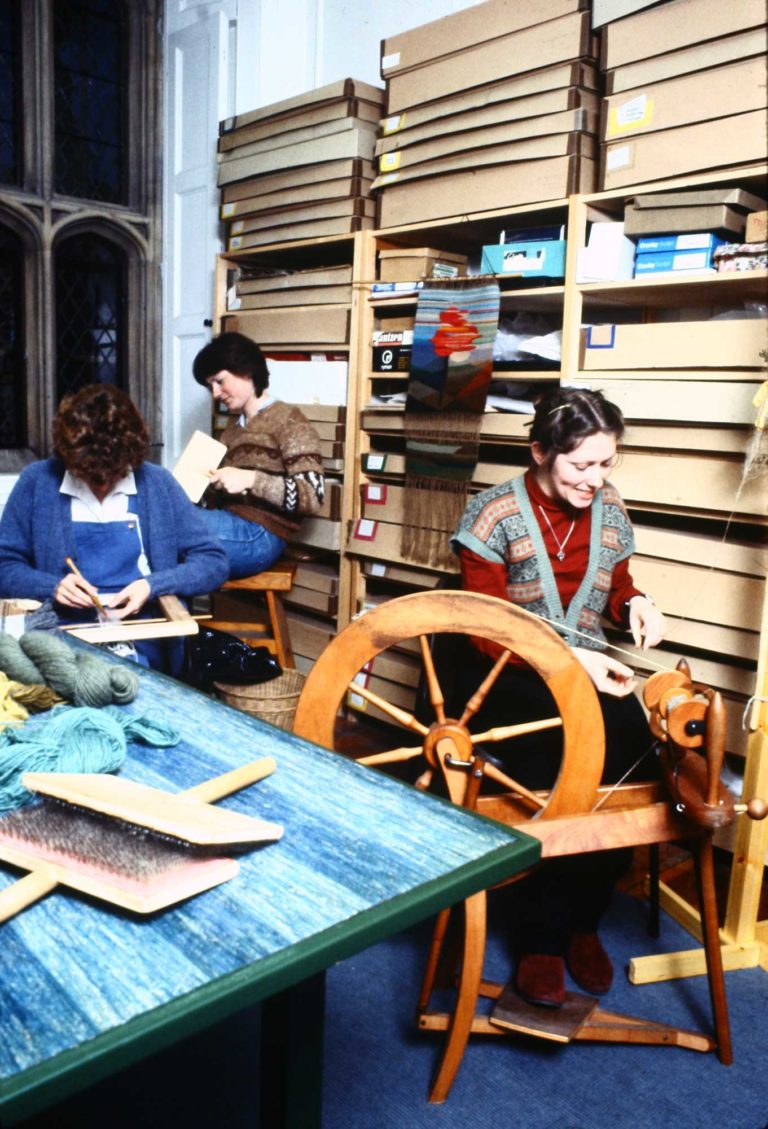

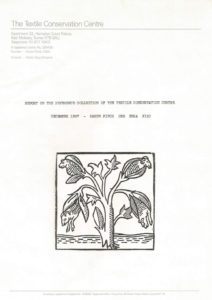
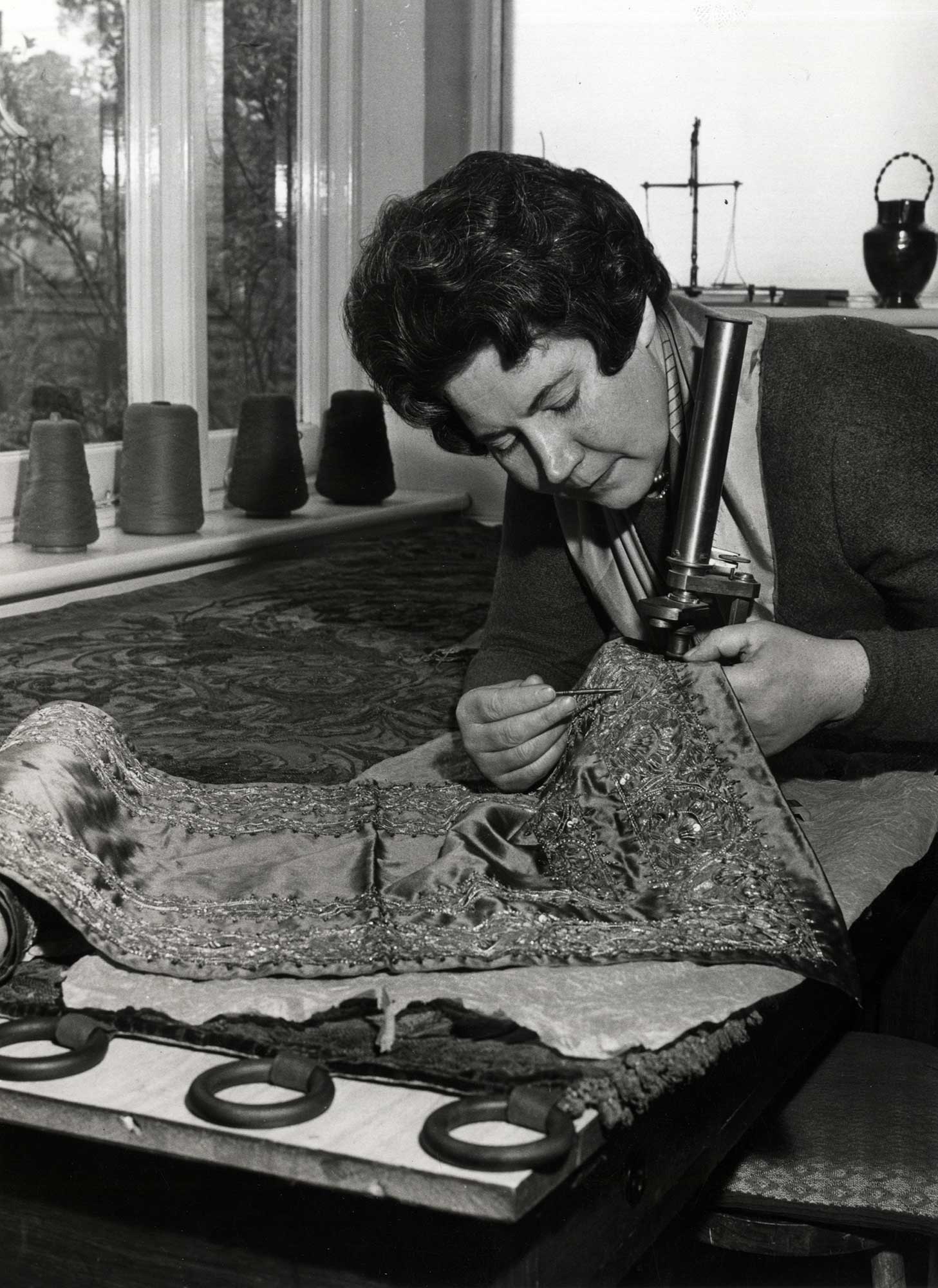
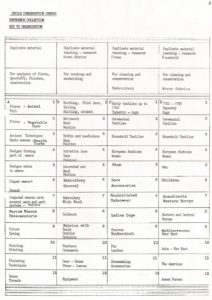
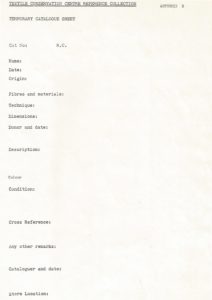

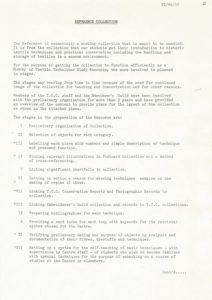

You are not currently logged in. Please log in or register for an account or leave a comment as a guest below.